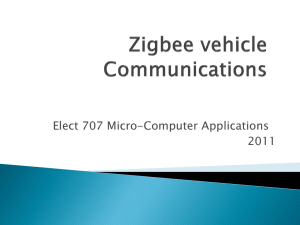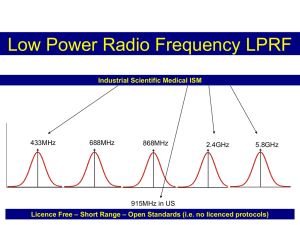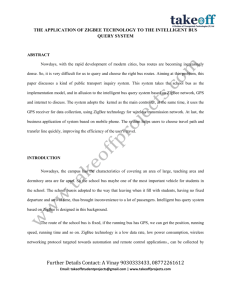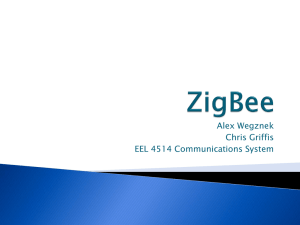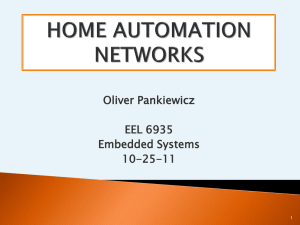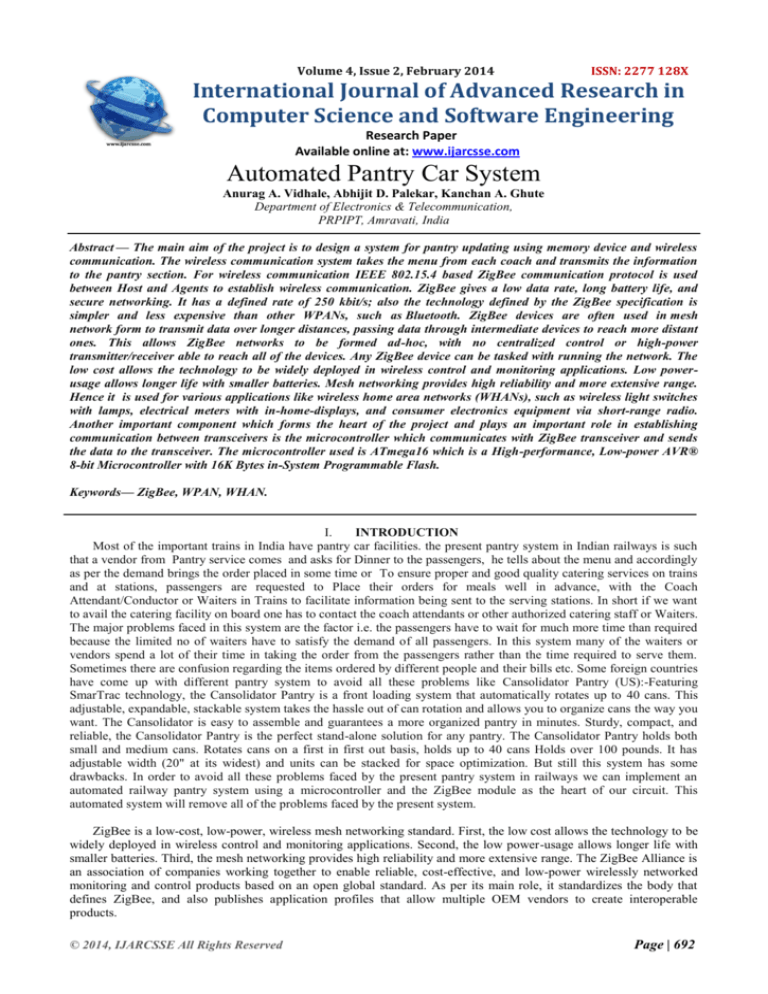
Volume 4, Issue 2, February 2014
ISSN: 2277 128X
International Journal of Advanced Research in
Computer Science and Software Engineering
Research Paper
Available online at: www.ijarcsse.com
Automated Pantry Car System
Anurag A. Vidhale, Abhijit D. Palekar, Kanchan A. Ghute
Department of Electronics & Telecommunication,
PRPIPT, Amravati, India
Abstract — The main aim of the project is to design a system for pantry updating using memory device and wireless
communication. The wireless communication system takes the menu from each coach and transmits the information
to the pantry section. For wireless communication IEEE 802.15.4 based ZigBee communication protocol is used
between Host and Agents to establish wireless communication. ZigBee gives a low data rate, long battery life, and
secure networking. It has a defined rate of 250 kbit/s; also the technology defined by the ZigBee specification is
simpler and less expensive than other WPANs, such as Bluetooth. ZigBee devices are often used in mesh
network form to transmit data over longer distances, passing data through intermediate devices to reach more distant
ones. This allows ZigBee networks to be formed ad-hoc, with no centralized control or high-power
transmitter/receiver able to reach all of the devices. Any ZigBee device can be tasked with running the network. The
low cost allows the technology to be widely deployed in wireless control and monitoring applications. Low powerusage allows longer life with smaller batteries. Mesh networking provides high reliability and more extensive range.
Hence it is used for various applications like wireless home area networks (WHANs), such as wireless light switches
with lamps, electrical meters with in-home-displays, and consumer electronics equipment via short-range radio.
Another important component which forms the heart of the project and plays an important role in establishing
communication between transceivers is the microcontroller which communicates with ZigBee transceiver and sends
the data to the transceiver. The microcontroller used is ATmega16 which is a High-performance, Low-power AVR®
8-bit Microcontroller with 16K Bytes in-System Programmable Flash.
Keywords— ZigBee, WPAN, WHAN.
I.
INTRODUCTION
Most of the important trains in India have pantry car facilities. the present pantry system in Indian railways is such
that a vendor from Pantry service comes and asks for Dinner to the passengers, he tells about the menu and accordingly
as per the demand brings the order placed in some time or To ensure proper and good quality catering services on trains
and at stations, passengers are requested to Place their orders for meals well in advance, with the Coach
Attendant/Conductor or Waiters in Trains to facilitate information being sent to the serving stations. In short if we want
to avail the catering facility on board one has to contact the coach attendants or other authorized catering staff or Waiters.
The major problems faced in this system are the factor i.e. the passengers have to wait for much more time than required
because the limited no of waiters have to satisfy the demand of all passengers. In this system many of the waiters or
vendors spend a lot of their time in taking the order from the passengers rather than the time required to serve them.
Sometimes there are confusion regarding the items ordered by different people and their bills etc. Some foreign countries
have come up with different pantry system to avoid all these problems like Cansolidator Pantry (US):-Featuring
SmarTrac technology, the Cansolidator Pantry is a front loading system that automatically rotates up to 40 cans. This
adjustable, expandable, stackable system takes the hassle out of can rotation and allows you to organize cans the way you
want. The Cansolidator is easy to assemble and guarantees a more organized pantry in minutes. Sturdy, compact, and
reliable, the Cansolidator Pantry is the perfect stand-alone solution for any pantry. The Cansolidator Pantry holds both
small and medium cans. Rotates cans on a first in first out basis, holds up to 40 cans Holds over 100 pounds. It has
adjustable width (20" at its widest) and units can be stacked for space optimization. But still this system has some
drawbacks. In order to avoid all these problems faced by the present pantry system in railways we can implement an
automated railway pantry system using a microcontroller and the ZigBee module as the heart of our circuit. This
automated system will remove all of the problems faced by the present system.
ZigBee is a low-cost, low-power, wireless mesh networking standard. First, the low cost allows the technology to be
widely deployed in wireless control and monitoring applications. Second, the low power-usage allows longer life with
smaller batteries. Third, the mesh networking provides high reliability and more extensive range. The ZigBee Alliance is
an association of companies working together to enable reliable, cost-effective, and low-power wirelessly networked
monitoring and control products based on an open global standard. As per its main role, it standardizes the body that
defines ZigBee, and also publishes application profiles that allow multiple OEM vendors to create interoperable
products.
© 2014, IJARCSSE All Rights Reserved
Page | 692
Anurag et al., International Journal of Advanced Research in Computer Science and Software Engineering 4(2),
February - 2014, pp. 692-699
II.
LITERATURE REVIEW
The name ―ZigBee‖ refers to the waggle dance of honey bees after their return to the beehive. The past several years
have witnessed a rapid development in the wireless network area. So far wireless networking has been focused on highspeed and long range applications. However, there are many wireless monitoring and control applications for industrial
and home environments which require longer battery life, lower data rates and less complexity than those from existing
standards. What the market need is a global standard that meets the requirement for reliability, security, low power and
low cost. For such wireless applications a new standard called ZigBee has been developed by the ZigBee Alliance based
upon the IEEE 802.15.4 standard. ZigBee-style networks began to be conceived around 1998, when many installers
realized that both Wi-Fi and Bluetooth were going to be unsuitable for many applications. In particular, many engineers
saw a need for self-organizing ad-hoc digital radio networks. The IEEE 802.15.4-2003 standard was completed in May
2003 and has been superseded by the publication of IEEE 802.15.4-2006 The ZigBee Alliance was announced in October
2004 The ZigBee specifications were ratified on 14 December 2004. The ZigBee Alliance announced availability of
Specification 1.0 on 13 June 2005, known as ZigBee 2004 Specification. In September 2006, ZigBee 2006 Specification
is announced. In 2007, ZigBee PRO, the enhanced ZigBee specification was finalized. ZigBee is a specification for a
suite of high level communication protocols using small, low-power digital radios based on an IEEE 802 standard for
personal area networks. ZigBee devices are often used in mesh network form to transmit data over longer distances,
passing data through intermediate devices to reach more distant ones. This allows ZigBee networks to be formed ad-hoc,
with no centralized control or high-power transmitter/receiver able to reach all of the devices. Any ZigBee device can be
tasked with running the network. ZigBee is targeted at applications that require a low data rate, long battery life, and
secure networking. ZigBee has a defined rate of 250 kbit/s, best suited for periodic or intermittent data or a single signal
transmission from a sensor or input device. Applications include wireless light switches, electrical meters with in-homedisplays, traffic management systems, and other consumer and industrial equipment that requires short-range wireless
transfer of data at relatively low rates. The technology defined by the ZigBee specification is intended to be simpler and
less expensive than other WPANs, such as Bluetooth. As ZigBee is a low-cost, low-power, wireless mesh
network standard. The low cost allows the technology to be widely deployed in wireless control and monitoring
applications. Low power-usage allows longer life with smaller batteries. Mesh networking provides high reliability and
more extensive range. ZigBee chip vendors typically sell integrated radios and microcontrollers with between 60 KB and
256 KB flash memory. The ZigBee network layer natively supports both star and tree typical networks, and generic mesh
networks. Every network must have one coordinator device, tasked with its creation, the control of its parameters and
basic maintenance. Within star networks, the coordinator must be the central node. Both trees and meshes allow the use
of ZigBee routers to extend communication at the network level. ZigBee is not intended to support power line but to
interface with it at least for smart metering and smart appliance purposes.
Typical application areas of Zigbee include Home Entertainment and Control — Home automation, smart lighting,
advanced temperature control, safety and security, movies and music Starting with individual sensors like Telosb/Tmote
and Iris from Memsic, Industrial control, Embedded sensing, Medical data collection, Smoke and intruder warning,
Building automation.
III.
SYSTEM ARCHITECTURE & WORKING
A. ZigBee
ZigBee is a specification for a suite of high level communication protocols using small, low-power digital radios
based on the IEEE 802.15.4-2003 standard for wireless home area networks (WHANs), such as wireless light switches
with lamps, electrical meters with in-home-displays, consumer electronics equipment via short-range radio. The
technology defined by the ZigBee specification is intended to be simpler and less expensive than other WPANs, such as
Bluetooth. ZigBee is targeted at radio-frequency (RF) applications that require a low data rate, long battery life, and
secure networking.
Fig. 1 Block Diagram for Transmission & Reception.
© 2014, IJARCSSE All Rights Reserved
Page | 693
Anurag et al., International Journal of Advanced Research in Computer Science and Software Engineering 4(2),
February - 2014, pp. 692-699
Our aim is to build an automated wireless pantry order system using ZigBee. We shall provide each
bogie/compartment with a microcontroller based order placement unit. The unit shall have a keypad to browse through
the menu. The menu items, their cost and information shall be displayed on the LCD connected to microcontroller. User
can navigate through menu using keypad provided. The data for the menu can be written on an EEPROM connected to
each such microcontroller based unit, so that portable data updating is possible (by changing only the EEPROM). Upon
finalizing the order the user will be able to place it using keypad. The order placed shall be transmitted to the central
server (PC) which will also have a ZigBee module connected to it for data reception. Multiple such slave units can be
installed; one in each compartment and so on.
Table 1 Specification for ZigBee.
Specification
XBee
XBee-PRO
Performance
Indoor/Urban Range
Up to 100 ft (30 m)
Outdoor RF line-of-sight
Range
Up to 300 ft (90 m)
Transmit Power Output
(software selectable)
1mW (0 dBm)
RF Data Rate
250,000 bps
Up to 300 ft. (90 m), up to 200 ft (60
m) International variant
Up to 1 mile (1600 m), up to 2500 ft
(750 m)
international variant
63mW (18dBm)*
10mW (10 dBm) for International
variant
250,000 bps
Serial Interface Data Rate 1200 bps - 250 kbps
1200 bps - 250 kbps
(software selectable)
(non-standard baud rates also supported) (non-standard baud rates also supported)
Receiver Sensitivity
-92 dBm (1% packet error rate)
-100 dBm (1% packet error rate)
Power Requirements
Supply Voltage
2.8 – 3.4 V
2.8 – 3.4 V
Transmit Current (typical) 45mA (@ 3.3 V)
250mA (@3.3 V) (150mA for
international variant) RPSMA
module only: 340mA (@3.3 V)
(180mA for international variant)
Idle / Receive Current
(typical)
50mA (@ 3.3 V)
55mA (@ 3.3 V)
Power-down Current
< 10 µA
< 10 µA
General
Operating Frequency
ISM 2.4 GHz
ISM 2.4 GHz
Dimensions
0.960‖ x 1.087‖ (2.438cm x 2.761cm)
0.960‖ x 1.297‖ (2.438cm x 3.294cm)
Operating Temperature
-40 to 85º C (industrial)
-40 to 85º C (industrial)
Antenna Options
Integrated Whip, Chip or U.FL
Connector, RPSMA Connector
Integrated Whip, Chip or U.FL
Connector, RPSMA Connector
Networking & Security
Supported Network
Topologies
Point-to-point, Point-to-multipoint &
Peer-to-peer
Number of Channels
(software selectable)
Addressing Options
16 Direct Sequence Channels
PAN ID, Channel and Addresses
12 Direct Sequence Channels
PAN ID, Channel and Addresses
United States (FCC Part
15.247)
Industry Canada (IC)
OUR-XBEE
OUR-XBEEPRO
4214A XBEE
4214A XBEEPRO
Europe (CE)
ETSI
ETSI (Max. 10 dBm transmit power
output)*
Agency Approvals
© 2014, IJARCSSE All Rights Reserved
Page | 694
Anurag et al., International Journal of Advanced Research in Computer Science and Software Engineering 4(2),
February - 2014, pp. 692-699
R201WW08215111 (Max. 10 dBm
Japan
R201WW07215214
transmit power output)*
Australia
C-Tick
C-Tick
ADC and I/O line support
Analog-to-digital conversion, Digital I/O I/O Line Passing
Easy-to-Use
No configuration necessary for out-of box
RF communications
Free X-CTU Software (Testing and configuration software)
AT and API Command Modes for configuring module parameters
Extensive command set
Small form factor
Fig. 2 Pin Diagram for Transmission and Reception.
B. COMPONENTS
1. ATMEGA16, 8-bit Microcontroller with 16K Bytes in-System Programmable Flash
It is a power CMOS 8-bit microcontroller based on the AVR enhanced RISC architecture. By executing powerful
instructions in a single clock cycle, the ATmega16 achieves throughputs approaching 1 MIPS per MHz allowing
the system designed to optimize power consumption versus processing speed.
Features
i. High-performance, Low-power AVR 8-bit Microcontroller
ii. Advanced RISC Architecture
131 Powerful Instructions – Most Single-clock Cycle Execution
32 x 8 General Purpose Working Registers
Fully Static Operation
Up to 16 MIPS Throughput at 16 MHz
On-chip 2-cycle Multiplier
iii. Nonvolatile Program and Data Memories
16K Bytes of In-System Self-Programmable Flash Endurance: 10,000 Write/Erase Cycles
Optional Boot Code Section with Independent Lock Bits In-System Programming by on-chip Boot Program
© 2014, IJARCSSE All Rights Reserved
Page | 695
Anurag et al., International Journal of Advanced Research in Computer Science and Software Engineering 4(2),
February - 2014, pp. 692-699
True Read-While-Write Operation
512 Bytes EEPROM Endurance: 100,000 Write/Erase Cycles
1K Byte Internal SRAM
Programming Lock for Software Security
iv. JTAG (IEEE std. 1149.1 Compliant) Interface
Boundary-scan Capabilities According to the JTAG Standard
Extensive On-chip Debug Support
Programming of Flash, EEPROM, Fuses, and Lock Bits through the JTAG Interface
v. Peripheral Features
Two 8-bit Timer/Counters with Separate Prescalers and Compare Modes
O n e 16-bit Timer/Counter with Separate Prescaler, Compare Mode and Capture Mode.
Real Time Counter with Separate Oscillator
Four PWM Channels
8-channel, 10-bit ADC
8 Single-ended Channels
7 Differential Channels in TQFP Package Only
2 Differential Channels with Programmable Gain at 1x, 10x, or 200x
Byte-oriented Two-wire Serial Interface
Programmable Serial USART
Master/Slave SPI Serial Interface
Programmable Watchdog Timer with Separate On-chip Oscillator
On-chip Analog Comparator
vi. Special Microcontroller Features
Power-on Reset and Programmable Brown-out Detection
Internal Calibrated RC Oscillator
External and Internal Interrupt Sources
Six Sleep Modes: Idle, ADC Noise Reduction, Power-save, Power-down, Standby and Extended Standby.
vii. I/O and Packages
32 Programmable I/O Lines
40-pin PDIP, 44-lead TQFP, and 44-pad MLF
viii. Operating Voltages
2.7 - 5.5V for ATmega16L
4.5 - 5.5V for ATmega16
ix. Speed Grades
0 - 8 MHz for ATmega16L
0 - 16 MHz for ATmega16
2. Systronix 20x4 LCD
Here is brief data for the Systronix 20x4 character LCD. It is a Data Vision part and uses the Samsung KS0066 LCD
controller. This 20x4 LCD is electrically and mechanically interchangeable with 20x4 LCDs from several other vendors.
The only differences we’ve seen among different 20x4 LCDs are: 1) LED backlight brightness, voltage and current vary
widely, as does the quality of the display 2) There is a resistor ―Rf‖ which sets the speed of the LCD interface by
controlling the internal oscillator frequency. Several displays we have evaluated have a low resistor value. This makes
the display too slow. Looking at the Hitachi data sheet page 56, it appears that perhaps the ―incorrect‖ resistor is really
intended for 3V use of the displays. At 5V the resistor Rf should be 91 Kohms. At 3V it should be 75 Kohms. Using a 3V
display at 5V is acceptable from a voltage standpoint (the display can operate on 3-5V) but the oscillator will then be
running too slowly. One fix is to always check the busy flag and not use a fixed time delay in your code, and then it will
work regardless of the LCD speed. The other option is to always allow enough delay for the slower display.All Systronix
20x4 LCDs have the 91 Kohm resistor and are intended for 5V operation
Table No. 2: Specification of Pin Diagram
Pin
Name
1
VCC
-
Power supply
2
DOUT
Output
UART Data Out
Input
UART Data In
Digital Output 8
3
DIN / CONFIG
Direction
4
DO8*
Output
5
RESET
Input
© 2014, IJARCSSE All Rights Reserved
Description
Module Reset (reset pulse must be at least 200
ns)
Page | 696
Anurag et al., International Journal of Advanced Research in Computer Science and Software Engineering 4(2),
February - 2014, pp. 692-699
6
PWM0 / RSSI
Output
PWM Output 0 / RX Signal Strength
Indicator
7
PWM1
Output
PWM Output 1
8
9
[reserved]
DTR / SLEEP_RQ / DI8
Input
10
GND
-
11
AD4 / DIO4
Either
12
CTS / DIO7
Either
13
ON / SLEEP
Output
14
VREF
15
Associate / AD5 / DIO5
Input
Pin Sleep Control Line or Digital Input 8
Ground
Analog Input 4 or Digital I/O 4
Clear-to-Send Flow Control or Digital I/O 7
Module Status Indicator
Voltage Reference for A/D Inputs
Either
Associated Indicator, Analog Input 5 or Digital
I/O 5
Request-to-Send Flow Control, Analog Input 6 or
Digital I/O 6
Analog Input 3 or Digital I/O 3
Analog Input 2 or Digital I/O 2
Analog Input 1 or Digital I/O 1
Analog Input 0 or Digital I/O 0
16
RTS / AD6 / DIO6
Either
17
18
19
20
AD3
AD2
AD1
AD0
Either
Either
Either
Either
/ DIO3
/ DIO2
/ DIO1
/ DIO0
Do not connect
3. XBee/XBee‐PRO RF Modules
The XBee and XBee-PRO RF Modules were engineered to meet IEEE 802.15.4 standards and support the unique
needs of low-cost, low-power wireless sensor networks. The modules require minimal power and provide reliable
delivery of data between devices. The modules operate within the ISM 2.4 GHz frequency band and are pin-for-pin
compatible with each other.
Features
i. Long Range Data Integrity
XBee
Indoor/Urban: up to 100’ (30 m)
Outdoor line-of-sight: up to 300’ (90 m)
Transmit Power: 1 mW (0 dBm)
Receiver Sensitivity: -92 dBm
XBee-PRO
Indoor/Urban: up to 300’ (90 m), 200' (60 m) for International variant
Outdoor line-of-sight: up to 1 mile (1600 m), 2500' (750 m) for International variant
Transmit Power: 63mW (18dBm), 10mW (10dBm) for International variant
Receiver Sensitivity: -100 dBm
RF Data Rate: 250,000 bps
ii. Advanced Networking & Security
iii. Retries and Acknowledgement
iv. Low Power
XBee
TX Peak Current: 45 mA (@3.3 V)
RX Current: 50 mA (@3.3 V)
Power-down Current: < 10 µA
XBee-PRO
TX Peak Current: 250mA (150mA for international variant)
TX Peak Current (RPSMA module only): 340mA (180mA for international varian
RX Current: 55 mA (@3.3 V)
Power-down Current: < 10 µA
v. ADC and I/O line support
Analog-to-digital conversion, Digital I/O I/O Line Passing
vi. Easy-to-Use
No configuration necessary for out-of box
RF communications
Free X-CTU Software (Testing and configuration software)
AT and API Command Modes for configuring module parameters
© 2014, IJARCSSE All Rights Reserved
Page | 697
Anurag et al., International Journal of Advanced Research in Computer Science and Software Engineering 4(2),
February - 2014, pp. 692-699
Extensive command set
Small form factor
IV.
RESULT
After running file in VB, the Output is shown as follows.
Fig. 3 Project Model
This is the project model for Pantry Car system. After running the program in VB and connecting the ZigBee module
to USB port, the LCD 20 X 4 displays will show ―ENTER PNR NO.‖ After entering the PNR NO. Click on Menu button
then the Display will show the menus as follows
Fig. 4 LCD Display Showing the Menu entered
After entering the Menu the system will show the final total amount on LCD display as follows
Fig. 5 LCD display showing the total amount
After showing the Amount on display the order will be sent on receiver side with the help of ZigBee module
connected to receiver side as shown follows
© 2014, IJARCSSE All Rights Reserved
Page | 698
Anurag et al., International Journal of Advanced Research in Computer Science and Software Engineering 4(2),
February - 2014, pp. 692-699
Fig. 6 Order showing on receiver side
After that bill will be printed on both the side i.e. transmitter as well as receiver.
Fig. 7 Printed Bill
V.
CONCLUSION
Wireless technology is becoming more and more popular because of its low cost and ease-of-use. This technology
allows us a faster and more convenient access to the world. ZIGBEE technology provides the world with a variety of
wireless applications. The Restaurant Automation not only gives the customers an insight into how their food is being
prepared but also the nutritional content that it carries. It is amazing that the customers can actually see their food even
before it’s delivered to them. The Restaurant automation is a revolutionary concept & is sure to take people by surprise.
It will undoubtedly change the way people dine & their dining habits. It would lead to increased revenues; give the
customer a better insight into the kind of food they wish to have, given them a great touch experienced.
REFERENCES
[1] Pasquale Catalano, Flavio Fucci, Giovanna La Fianza and Ferruccio Giametta, Agricultural Engineering
International: the CIGRE journal, Vol. X. January, 2008.
[2] Kapil Bhoria and Harish Rohil. Performance Analysis of IEEE 802.11b, 802.15.1 and 802.16a Standards, IJCST,
Vol. 3, Issue 1, Jan. - March 2012.
[3] Jin-Shyan Lee, Yu-Wei Su and Chung-Chou Shen, a Comparative Study of Wireless Protocols: Bluetooth, UWB,
Zigbee, and Wi-Fi, The 33rd Annual Conference of the IEEE Industrial Electronics Society (IECON), Nov. 5-8,
2007, Taipei, Taiwan.
[4] Ms. Dharmistha, D. Vishwakarma. IEEE 802.15.4 and Zigbee: A Conceptual Study, International Journal of
Advanced Research in Computer and Communication Engineering, Vol. 1, Issue 7, September 2012.
[5] XBee®/XBee-PRO® RF Modules, IEEE® 802.15.4 RF Modules by Digi International.
[6] AUBTM-20 Bluetooth V2.0 Class 2 module Product datasheet.
© 2014, IJARCSSE All Rights Reserved
Page | 699


